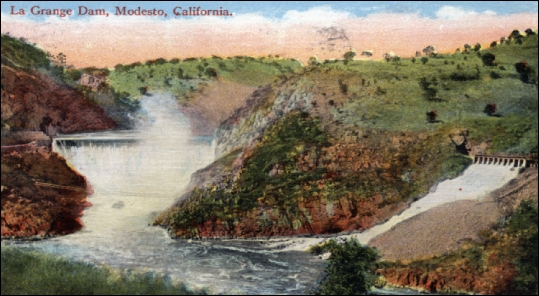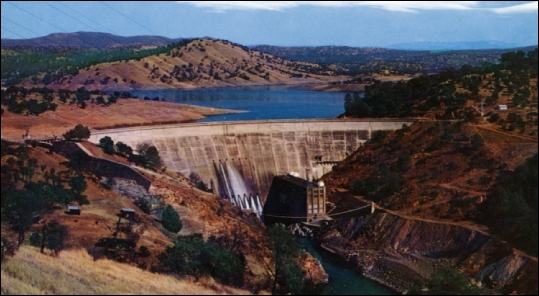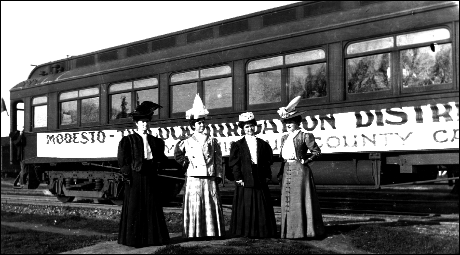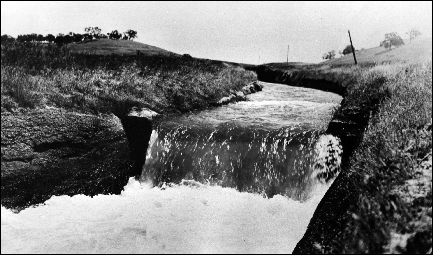Irrigation - Water Wealth The plains in this county could be irrigated by taking the water from the rivers running through it at the foot of the mountains by means of canals. It is not expedient at present for it would be attended with great expense and have but few consumers. We have good reason to believe from the situation of the arable land of this county that artesian wells could be sunk successfully; if so, it would be more convenient than any other mode of irrigation. - From a report by the county's first surveyor, Silas Wilcox, to the Surveyor General of the State of California, Nov. 10, 1854 | ||
Drought "With only one year in three producing sufficient rain to insure bountiful crops and with the specter of drought after drought constantly before them, menacing their prosperity and retarding the development of the county, the farmers of Paradise Valley in 1871 directed their attention to the provision of methods for the irrigation of their arid lands." - Stories of Stanislaus, Sol P. Elias
Hundreds of Miles of Canals The original plan for irrigation in Paradise Valley put forth in 1871 envisioned "at least 200 miles of main and banch canals - over 20 miles of which were to be through mountainous country" below Wheaton dam, a privatley owned overflow dam. State legislation was sought as "An Act to Encourage Irrigation," but was never realized because of a lack of participation by the farmers the plan would most benefit.
It became apparent that the primary crop of wheat was not as much in demand by the late 1870s, and the land was in need of replenishment from its continued use for growing one type of crop. To venture into a more varied agricultural base, water was the key ingredient.
Wright Irrigation Act It wasn't until 1887 that the state legislature passed the Wright Irrigation Act, sponsored by Modesto Assemblyman C.C. Wright, that allowed for the formation of irrigation districts "owned, financed and managed by the people." This led to the founding of the Modesto and Turlock irrigation districts and the battle to build a water delivery system in the region.
The first action was to build a dam on the Tuolumne River in the Sierra foothills. This resulted in LaGrange Dam: 128 feet, 6 inches high. It was completed in 1893, but water would not be delivered from the dam to the canals until 1900 in Turlock and 1903 in Modesto. Litigation from the anti-irrigationists kept the two districts in limbo for almost ten years. Here are Sol P. Elias's comments as recorded in Stories of Stanislaus:
"Water came to the Turlock District as early as 1900 and to Modesto District in 1903. In these years all difficulties had been overcome. The entire works were accomplished facts. The districts possessed as complete and as satisfactory a system of irrigation as could be found in any locality in the United Sates. The Jubilee which signalized the completeion was celebrated in Modesto in 1904.
Link: Who Was C.C. Wright?
Next: Early History/Timeline - 1870-1900 Previous: Early History/Changing Times/Vigilantes
| ||||
The two earliest dams for the Modesto and Turlock Irrigation districts are pictured here. Completed in 1893, the top postcard photo shows LaGrange Dam with water pouring over it. The bottom photo shows the original Don Pedro Dam, a concrete arch structure that was completed in 1924 above the site of LaGrange Dam on the Tuolumne River. The original concrete dam, which created Don Pedro Reservoir, was replaced by a larger earthen dam in 1970. The Don Pedro Dam and Reservoir were originally named for the gold rush town of Don Pedro Bar, located at the site of the dam and lake. | ||||
1904 Jubilee
To celebrate the opening of the canals and the flow of water to the agriculturally rich Stanislaus County area, the Modesto and Turlock Irrigation districts held a Jubilee in April of 1904 in Modesto. The celebration included train trips to look at the accomplishment for anyone interested. | Flowing Canal
One of the earliest photos of water flowing through a canal in the Modesto Irrigation District is shown above. It had taken 10 years from the completion of LaGrange Dam for litigation to be resolved to allow farmers to begin irrigating their fields. |




